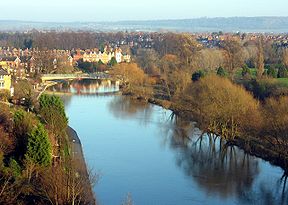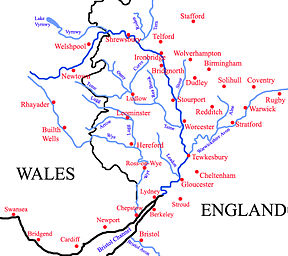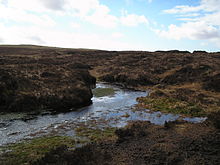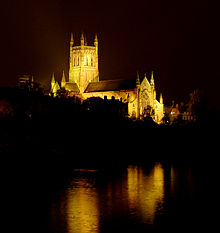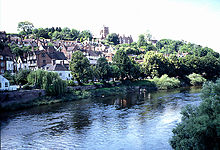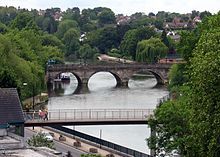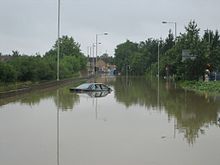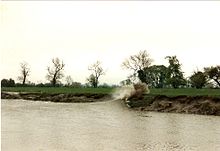
River Severn
Background to the schools Wikipedia
SOS Children, an education charity, organised this selection. Visit the SOS Children website at http://www.soschildren.org/
| River Severn | |
| Welsh: Afon Hafren, Latin: Sabrina | |
| River | |
|
The Severn at Shrewsbury from Shrewsbury Castle.
|
|
| Countries | United Kingdom, (Wales, England) |
|---|---|
| Regions | Mid Wales, West Midlands, South West |
| Administrative areas |
Powys, Shropshire, Worcestershire, Gloucestershire |
| Tributaries | |
| - left | Vyrnwy, Tern, Stour, Warwickshire Avon, Bristol Avon |
| - right | Teme, Wye |
| Cities | Shrewsbury, Worcester, Gloucester, Bristol |
| Landmarks | Ironbridge Gorge, Severn Valley, Severn Bore, Severn crossing |
| Source | |
| - location | Plynlimon, Ceredigion, Wales |
| - elevation | 610 m (2,001 ft) |
| - coordinates | 52.493465°N 3.734578°W |
| Mouth | Severn Estuary |
| - location | Bristol Channel, United Kingdom |
| - elevation | 0 m (0 ft) |
| Length | 354 km (220 mi) |
| Basin | 11,420 km2 (4,409 sq mi) |
| Discharge | for Bewdley, Worcs. SO 7815 7622 |
| - average | 61.17 m3/s (2,160 cu ft/s) |
| - max | 533.48 m3/s (18,840 cu ft/s) max recorded on 1947-03-21 |
The River Severn ( Welsh: Afon Hafren, Latin: Sabrina) is the longest river in the United Kingdom, at about 354 kilometres (220 mi), and the second longest in the British Isles, behind the River Shannon. It rises at an altitude of 610 metres (2,001 ft) on Plynlimon, Ceredigion near Llanidloes, Powys, in the Cambrian Mountains of mid Wales. It then flows through Shropshire, Worcestershire and Gloucestershire, with the county towns of Shrewsbury, Worcester, and Gloucester on its banks. With an average discharge of 107 m³/s at Apperley, Gloucestershire, the Severn is the greatest river in terms of water flow in England and Wales.
The river is usually considered to become the Severn Estuary after the Second Severn Crossing between Severn Beach, South Gloucestershire and Sudbrook, Monmouthshire. The river then discharges into the Bristol Channel which in turn discharges into the Celtic Sea and the wider Atlantic Ocean. The Severn's drainage basin area is 11,420 square kilometres (4,409 sq mi), excluding the River Wye and Bristol Avon which flow into the Severn Estuary. The major tributaries to the Severn are the Vyrnwy, Teme, Warwickshire Avon and Stour.
Etymology and mythology
The name Severn is thought to derive from a Celtic original name *sabrinn-â, of uncertain meaning. That name then developed in different languages to become Sabrina to the Romans, Hafren in Welsh, and Severn in English. A folk etymology later developed, deriving the name from a mythical story of a nymph, Sabrina, who drowned in the river. Sabrina is also the goddess of the River Severn in Brythonic mythology. The story of Sabrina is featured in Milton's Comus. There is a statue of 'Sabrina' in the Dingle Gardens at the Quarry, Shrewsbury. As the Severn becomes tidal the associated deity changed to Noadu (Romanized as Nodens), who was represented mounted on a seahorse, riding on the crest of the Severn bore.
Tributary rivers
The River Stour rises in the north of Worcestershire in the Clent Hills, near St Kenelm's Church at Romsley. It flows north into the adjacent West Midlands at Halesowen. It then flows westwards through Cradley Heath and Stourbridge where it leaves the Black Country. It is joined by the Smestow Brook at Prestwood before it winds around southwards to Kinver, and then flows back into Worcestershire. It then passes through Wolverley, Kidderminster and Wilden to its confluence with the Severn at Stourport-on-Severn.
The River Vyrnwy, which begins at Lake Vyrnwy, flows eastwards through Powys before forming the border between England and Wales, joining the Severn near Melverley, Shropshire. The Rea Brook flows north from its source in the Shropshire Hills and joins the Severn at Shrewsbury. The River Tern, after flowing south from Market Drayton and being joined by the River Roden, meets the Severn at Attingham Park.
The River Worfe joins the Severn, just above Bridgnorth. The River Stour rising on the Clent Hills and flowing through Halesowen, Stourbridge, and Kidderminster, joins the Severn at Stourport. On the opposite bank, the tributaries are only brooks, Borle Brook, Dowles Brook draining the Wyre Forest and Dick Brook.
The River Teme flows eastwards from its source in Mid Wales, straddling the border between Shropshire and Herefordshire, it is joined by the River Onny, River Corve and River Rea before it finally joins the Severn slightly downstream of Worcester. Shit Brook near Much Wenlock was culverted to flow into the Severn.
One of the several rivers named Avon, in this case the Warwickshire Avon, flows west through Rugby, Warwick and Stratford-upon-Avon. It is then joined by its tributary the River Arrow, before finally joining the Severn at Tewkesbury, Gloucestershire.
The port of Bristol is located on the Severn Estuary, where another River Avon flows into it through the Avon Gorge.
The River Wye, from its source in Plynlimon, Wales, flows generally south east through the Welsh towns of Rhayader and Builth Wells. It enters Herefordshire, flows through Hereford, and is shortly afterwards joined by the River Lugg, before flowing through Ross-on-Wye and Monmouth, and then southwards where it forms the boundary between England ( Forest of Dean) and Wales. It flows into the Severn near the town of Chepstow, slightly upstream of the Bristol Avon on the opposite bank.
The River Usk flows into the Severn Estuary just south of Newport.
Major settlements
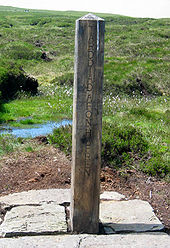
Below is a list of major towns and cities that the Severn flows through (in order running downstream): Through Powys:
- Newtown
- Welshpool
Through Shropshire:
- Shrewsbury (county town)
- Ironbridge
- Bridgnorth
Through Worcestershire:
- Bewdley and surrounding Villages
- Stourport
- Worcester (county town)
- Upton
Through Gloucestershire:
- Tewkesbury
- Gloucester (county town)
Transport
Bridges
The Severn is bridged at many places, and many of these bridges are notable in their own right, with several designed and built by the engineer Thomas Telford. There also is the famous Iron Bridge at Ironbridge, which was the world's first iron arch bridge.
The two road bridges of the Severn crossing link Wales with the southern counties of England.
- Severn Bridge — opened in 1966 carrying what is now the M48
- Second Severn Crossing — opened in 1996 carrying the M4 motorway
Prior to the construction of the first bridge in 1966, the channel was crossed by the Aust Ferry.
Rail
The Severn Tunnel, completed in 1886 by John Hawkshaw on behalf of the Great Western Railway, lies near the Second Severn Crossing road bridge, and carries the Great Western Main Line under the channel.
Cars could also be transported through the Severn Tunnel. In the 1950s three trains a day made round trips between Severn Tunnel Junction and Pilning. The vehicles were loaded onto open flat bed carriages and pulled by a small pannier tank locomotive, although sometimes they were joined to a scheduled passenger train. The prudent owner paid to cover the vehicle with a sheet, as sparks often flew when the steam locomotive tackled the slope leading to the tunnel exit. A rail coach was provided for passengers and drivers. Reservations could be made and the fee for the car was about thirty shillings (£1.50) in the early 1950s.
Disasters
There have been many disasters on the Severn and it has claimed many lives (figures vary depending on how it is recorded, circa 300 people), especially during the 20th century.
There is a public right of navigation between Pool Quay, near Welshpool, and Stourport. However this stretch of the river has little traffic, other than small pleasure boats, canoes and some tour boats in Shrewsbury. Below Stourport, where the river is more navigable for larger craft, users must obtain permits from the Canal & River Trust, who are the navigation authority. During spring freshet the river can be closed to navigation.
At Upper Parting above Gloucester, the river divides into two, and flows either side of Alney Island to Lower Parting. The West Channel is no longer navigable. The East Channel is navigable as far as Gloucester Docks, from where the Gloucester and Sharpness Canal provides a navigable channel south. Between the docks and Lower Parting Llanthony Weir marks the Normal Tidal Limit (NTL) of the East Channel of the river.
In the tidal section of the river below Gloucester, the Gloucester Harbour Trustees are the competent harbour authority.
Locks
There are locks on the lower Severn to enable seagoing boats to reach as far as Stourport. The most northerly lock is at Lincombe, about a mile downstream from Stourport.
Associated canals
| River Severn | |||||||||||||||||||||||||||||||||||||||||||||||||||||||||||||||||||||||||||||||||||||||||||||||||||||||||||||||||||||||||||||||||||||||||||||||||||||||||||||||||||||||||||||||||||||||||||||||||||||||||||||||||||||||||||||||||||||||||||||||||||||||||||||||||||||||||||||||||||||||||||||||||||||||||||||||||||||||||||||||||||||||||||||||||||||||||||||||||||||||||||||||||||||||||||||||||||||||||||||||||||||||||||||||||||||||||||||||||||||||||||||||||||||||||||||||||||||||||||||||||
|---|---|---|---|---|---|---|---|---|---|---|---|---|---|---|---|---|---|---|---|---|---|---|---|---|---|---|---|---|---|---|---|---|---|---|---|---|---|---|---|---|---|---|---|---|---|---|---|---|---|---|---|---|---|---|---|---|---|---|---|---|---|---|---|---|---|---|---|---|---|---|---|---|---|---|---|---|---|---|---|---|---|---|---|---|---|---|---|---|---|---|---|---|---|---|---|---|---|---|---|---|---|---|---|---|---|---|---|---|---|---|---|---|---|---|---|---|---|---|---|---|---|---|---|---|---|---|---|---|---|---|---|---|---|---|---|---|---|---|---|---|---|---|---|---|---|---|---|---|---|---|---|---|---|---|---|---|---|---|---|---|---|---|---|---|---|---|---|---|---|---|---|---|---|---|---|---|---|---|---|---|---|---|---|---|---|---|---|---|---|---|---|---|---|---|---|---|---|---|---|---|---|---|---|---|---|---|---|---|---|---|---|---|---|---|---|---|---|---|---|---|---|---|---|---|---|---|---|---|---|---|---|---|---|---|---|---|---|---|---|---|---|---|---|---|---|---|---|---|---|---|---|---|---|---|---|---|---|---|---|---|---|---|---|---|---|---|---|---|---|---|---|---|---|---|---|---|---|---|---|---|---|---|---|---|---|---|---|---|---|---|---|---|---|---|---|---|---|---|---|---|---|---|---|---|---|---|---|---|---|---|---|---|---|---|---|---|---|---|---|---|---|---|---|---|---|---|---|---|---|---|---|---|---|---|---|---|---|---|---|---|---|---|---|---|---|---|---|---|---|---|---|---|---|---|---|---|---|---|---|---|---|---|---|---|---|---|---|---|---|---|---|---|---|---|---|---|---|---|---|---|---|---|---|---|---|---|---|---|---|---|---|---|---|---|---|---|---|---|---|---|---|---|---|---|---|---|---|---|---|---|---|---|---|---|---|---|---|---|---|---|---|---|---|---|---|---|---|---|---|---|---|---|---|---|---|---|---|---|---|---|---|---|---|---|---|---|---|---|---|---|---|---|---|---|---|---|---|---|---|---|---|---|---|---|---|---|---|---|---|---|---|---|---|---|---|---|---|---|---|---|---|
|
Legend
|
|||||||||||||||||||||||||||||||||||||||||||||||||||||||||||||||||||||||||||||||||||||||||||||||||||||||||||||||||||||||||||||||||||||||||||||||||||||||||||||||||||||||||||||||||||||||||||||||||||||||||||||||||||||||||||||||||||||||||||||||||||||||||||||||||||||||||||||||||||||||||||||||||||||||||||||||||||||||||||||||||||||||||||||||||||||||||||||||||||||||||||||||||||||||||||||||||||||||||||||||||||||||||||||||||||||||||||||||||||||||||||||||||||||||||||||||||||||||||||||||||
The Staffordshire and Worcestershire Canal, the Worcester and Birmingham Canal, (both narrow beam) and the Herefordshire and Gloucestershire Canal all join the Severn at Stourport, Worcester and Gloucester respectively. The Droitwich Barge Canal, a broad beam canal joins the Severn at Hawford, near to the River Salwarpe, and connects to the Droitwich Canal (narrow beam) in the name town, which then forms a link to the Worcester and Birmingham Canal. The two Droitwich canals are due to re-open in 2010 after major restoration.
The Gloucester and Sharpness Canal connects the Severn at Gloucester to the Severn at Sharpness, avoiding a stretch of the tidal river which is dangerous to navigate. The Stroudwater Navigation used to join the tidal Severn at Framilode, but since the 1920s has connected to the Severn only via the Gloucester and Sharpness Canal.
The Lydney Canal is a short canal which connects Lydney to the river.
The section of the river between Tewkesbury and Worcester forms part of the Avon Ring, a 109-mile (175 km) circular cruising route which includes 129 locks and covers parts of three other waterways.
Passenger transport
The tidal river
Paddle steamers were operated in the Severn Estuary from the mid 19th century to the late 1970s by P and A Campbell of Bristol. Since 1986 Waverley Excursions has operated occasional sailings to Sharpness and Lydney by the MV Balmoral.
A number of ferries were also operated on the tidal river, for example at New Passage, Purton and Arlingham. The last ferry was the Aust Ferry, which closed in 1966 when the Severn Bridge opened. One of the Aust ferries, Severn Princess, is still in Chepstow although largely derelict.
The upper river
In Worcester, the Worcester River Cruises have boat trips up and down the river between Tewkesbury and Stourport, operating the boats The Pride of the Midlands and The Earl Grosvenor.
The Cathedral Ferry, a foot passenger ferry, also operates on Summer weekends from the steps of Worcester Cathedral.
In Shropshire the Hampton Loade Ferry operates across the river.
In Shrewsbury, boat trips around the loop of the town centre are at present provided by the Sabrina and depart from Victoria Quay near the Welsh Bridge during the summer.
Severn Estuary
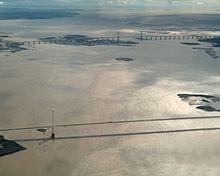
The river becomes tidal at Maisemore, on the West Channel just north of Gloucester, and at Llanthony Weir on the East Channel. The tidal river downstream from Gloucester is sometimes referred to as the Severn Estuary, but the river is usually considered to become the Severn Estuary after the Second Severn Crossing near Severn Beach, South Gloucestershire (the point to which the jurisdiction of the Gloucester Harbour Trustees extends), or at Aust, the site of the Severn Bridge.
The Severn Estuary extends to a line from Lavernock Point (south of Cardiff) to Sand Point near Weston-super-Mare. West of this line is the Bristol Channel. In the Severn Estuary (or the Bristol Channel in the last two cases, depending where the boundary is drawn) are the rocky islands called Denny Island, Steep Holm and Flat Holm.
The estuary is about 2 miles (3.2 km) wide at Aust, and about 9 miles (14 km) wide between Cardiff and Weston-super-Mare.
Severn Sea
Until Tudor times the Bristol Channel was known as the Severn Sea, and it is still known as this in both Welsh and Cornish (Môr Hafren and Mor Havren respectively, with Môr meaning Sea).
Severn bore
A curious phenomenon associated with the lower reaches of the Severn is the tidal bore, which forms somewhat upstream of the port of Sharpness.
It is frequently asserted that the river's estuary, which empties into the Bristol Channel, has the second largest tidal range in the world—14.5 metres (48 ft), exceeded only by the Bay of Fundy. However a tidal range greater than that of the Severn is recorded from the lesser known Ungava Bay in Canada. During the highest tides, the rising water is funnelled up the Severn estuary into a wave that travels rapidly upstream against the river current. The largest bores occur in spring, but smaller ones can be seen throughout the year. The bore is accompanied by a rapid rise in water level which continues for about one and a half hours after the bore has passed.
Industry
A 5-kilometre (3.1 mi) stretch of the River Severn in Shropshire, is known as Ironbridge Gorge. It was designated a World Heritage Site by UNESCO in 1986. Its historic importance is due to its role as the centre of the iron industry in the early stages of the Industrial Revolution. The gorge and the village of Ironbridge get their name from the Iron Bridge across the Severn, built in 1779, which was the first cast-iron arch bridge ever constructed.
Wildlife
The sides of the estuary are also important feeding grounds for waders, notably at the Bridgwater Bay National Nature Reserve and the Slimbridge Wildfowl Trust.
Literary allusions
The River Severn is named several times in A.E. Housman's A Shropshire Lad (1896): “It dawns in Asia, tombstones show/And Shropshire names are read;/And the Nile spills his overflow/Beside the Severn’s dead” (“1887”); “Severn stream” (“The Welsh Marches”); and “Severn shore” (“Westward from the high-hilled plain…”).
In William Shakespeare's " Henry IV, Part 1," Henry Hotspur Percy recalls the valor of Edmund Mortimer, 5th Earl of March in a long battle against Welshman Owain Glyndŵr upon The Severn's banks, claiming the flooding Severn "affrighted with (the warriors') bloody looks ran fearfully among the trembling reeds and hid his crisp head in the hollow bank, bloodstained with these valiant combatants."
